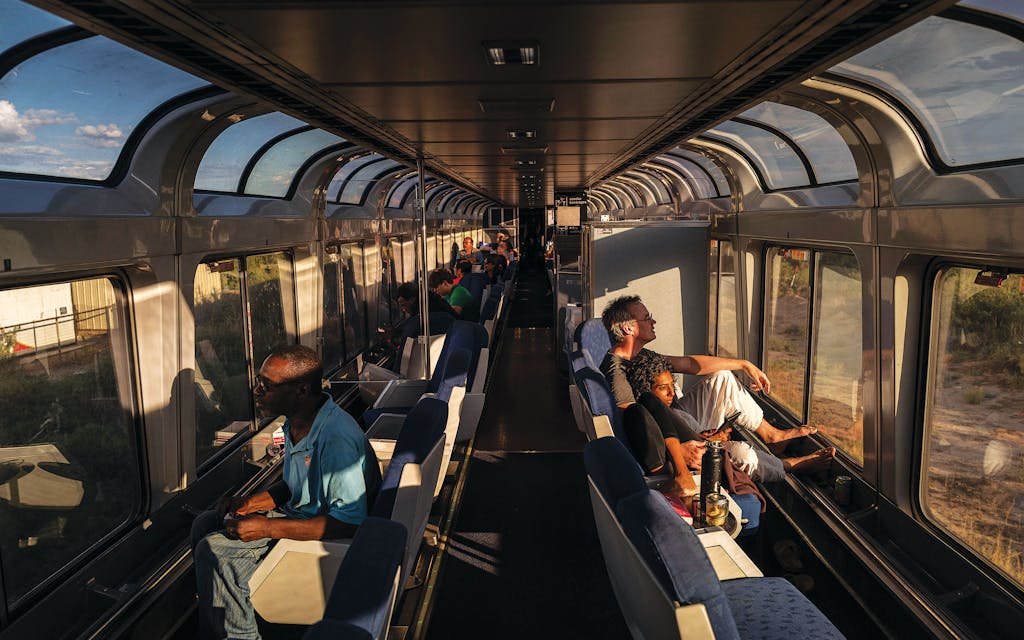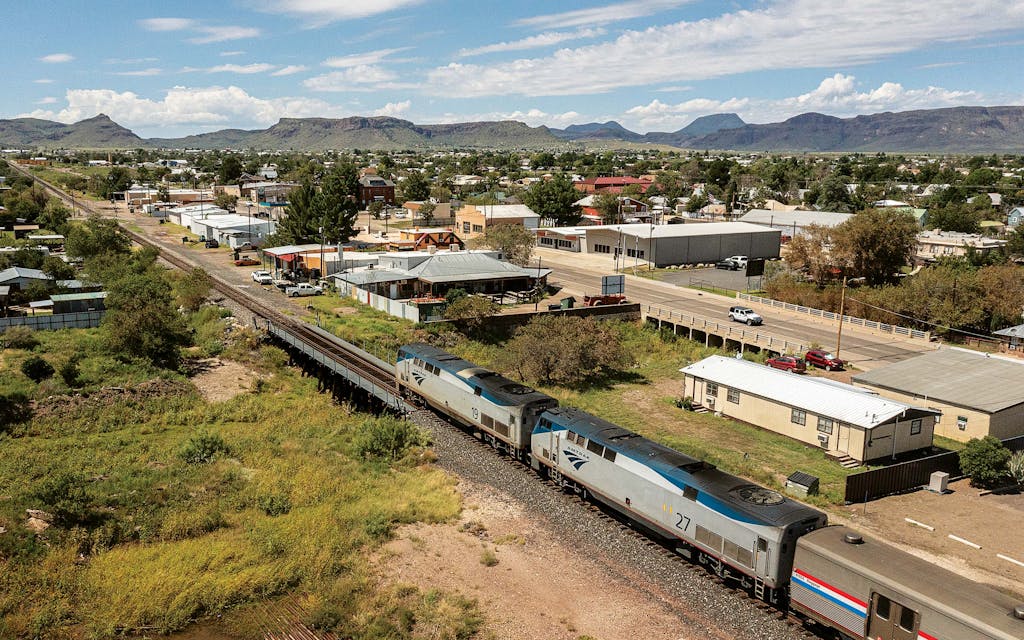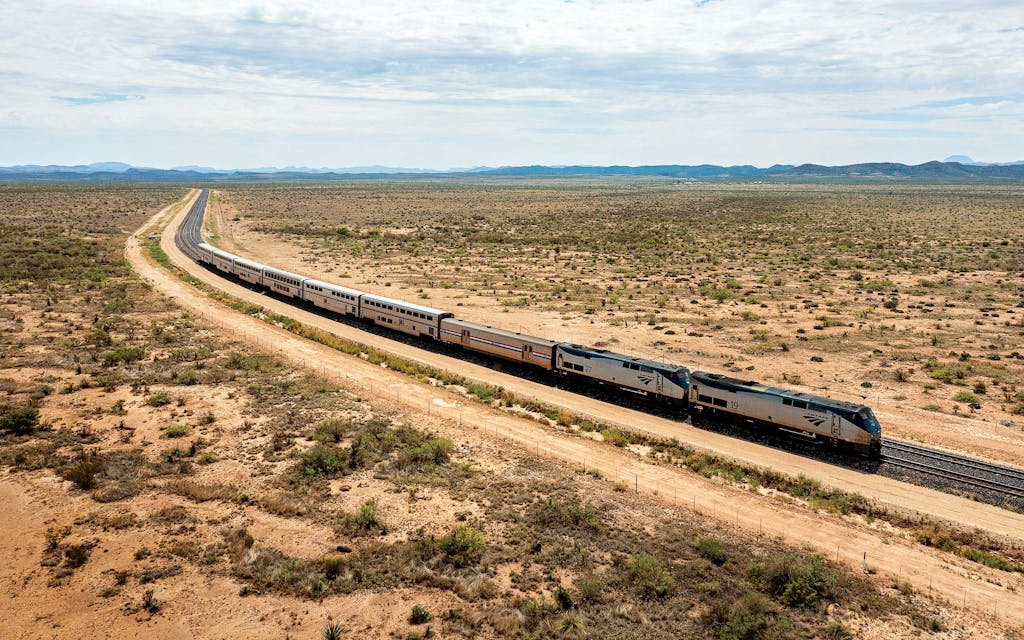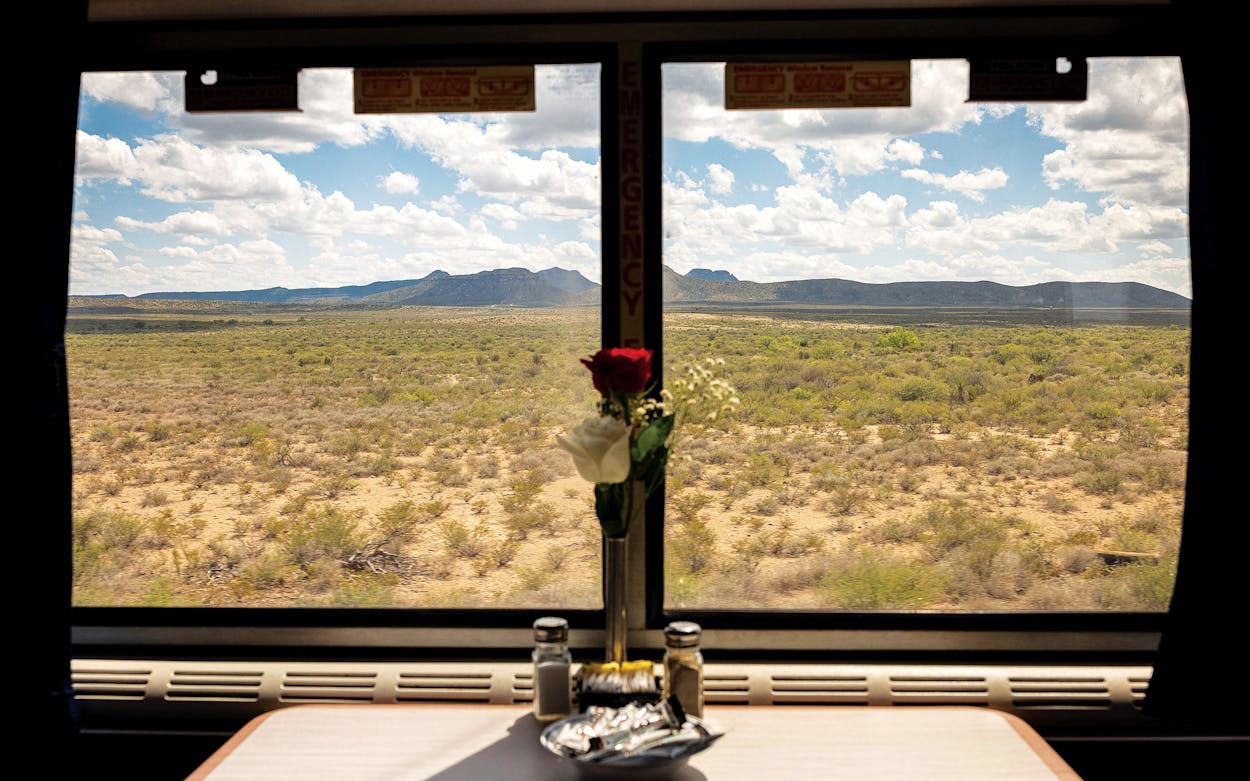The road to far West Texas is rambling, which is to say there’s no easy way to get there, no matter where you’re coming from. I learned this quickly during my three years as a community reporter in the tiny border town of Presidio. When you don’t have a car, there are few options for travel. There is, however, a train.
The Sunset Limited sounds much lovelier than it is; maybe it was once. Its current fleet, consisting of double-decker trains called Superliners, was built mostly in the eighties and retains the angular aesthetic of that era. The interior is heavy on sapphire blue. It’s the oldest named passenger route still in operation in the U.S., dating to 1894, and was originally part of the Southern Pacific Railroad. Nowadays it’s Amtrak’s southernmost route, and it runs from New Orleans to Los Angeles and back, cutting through Texas three days out of each week, where it makes seven stops: Beaumont, Houston, San Antonio, Del Rio, Sanderson, Alpine, and El Paso. The entire 1,995-mile trek takes about 48 hours one way, and nearly half that journey happens in our state. I tell you this in case you’ve forgotten how big Texas is, or in case you never knew.

The first time I took the Sunset Limited, in 2014, I was making my maiden voyage to West Texas. I flew to San Antonio from New York City. My plan was to catch the train to Alpine, a nearly eight-hour trip that would put me there by midmorning the next day. With several hours to kill, I arrived at the downtown station early and sat in the waiting room, which was bathed in a buzzing white light. The shelves along the wall were stuffed with pamphlets that bent at the middle as if they’d been standing for a decade too long. The quarter machines were half-filled with candy that had turned as good as gravel. While I struggled to stay awake, a young roughneck named Blaze held out his phone and proudly showed me photos of his two trucks as if they were his nieces.
When the train finally came, we shuffled into the cool outdoors, a slumped and motley queue. I found my assigned seat, in passenger car three on the upper level beside a window, and settled in, resting my head against the glass and stretching my legs out to meet the footrest. The seats, though old, were relatively comfortable and, unlike those on an airplane, truly reclined.
Sometime around dawn I awakened as the woman across the aisle spoke softly into her phone: “It’s going to be okay,” she said. “It’s only second-degree burns.” We’d left the strip malls and city grid of San Antonio and entered the lonely desert, flanked on either side by hills shaped by erosion. The woman’s dark hair was held back by a faded magenta bandanna. “They don’t know if he’s gonna get a skin graft yet.” The sun was beginning to rise, and then the dust lifted, trapped at the foot of the mountains, a veil of matter refracting the first bit of light. She looked out the window, her bandanna a rose in the glass. “Now that I’m on my way, I’m a bit calmer than before. I’m on the train. Only had enough for the train.” She sighed, accompanied by the murmur of the rails, by the suction-clank of the car door opening as someone walked through. “We’re passing through the desert now. It’s so beautiful, all the colors and shapes.” All the colors and shapes. An Exxon sign extending an arm of light into the twilight. The sky, pink like a wound.

The sprawl of travel-worn bodies, the open maw of a sleeping face, possessions strewn across seats, crumbs scattered down the aisle like they’re forging the way home—this wasn’t the freedom of the road Jack Kerouac described, in which leaving the multitudes behind is as easy as picking a point on a map and driving away. On the train you’re among the masses, and it’s impossible to look away.
After moving to Presidio, I took this train more times than I can count, each trip a wild journey featuring a new cast of characters: the man who readily showed me the gunshot wounds on his torso and the machete in his bag; the jaded young soldier on leave making eyes at a pretty runaway, who played coy. It was always strange and moving at the same time: once I awakened to discover the elderly man seated next to me had covered me in his wool blanket.
Compared with other countries that have developed high-speed systems, America’s rail network is slow and otherwise lacking. In Texas, it’s rarely a matter of convenience when a person chooses to take the train; rather, it’s often because of cost considerations or a fear of flying.
Why do I prefer to ride the train? Maybe because I’m fascinated by people’s stories, and the train is full of them. Or maybe because choosing to slow down feels like its own kind of freedom. Though I live in Austin now, I still like to ride the Amtrak when I journey out west. I block out a span of time to get there; I consider it an indulgence. And yet, in all these years, I’d never experienced the ultimate in rail travel: the sleeper car. It was time I gave it a try.

On a spring night in Austin, I waited to board the Texas Eagle, another Amtrak route that connects to the Sunset Limited in San Antonio. Not surprisingly, the train was late, the fault of freight traffic. But this trip, to see friends in Alpine, would be different in one major way: I would have my own room. I had booked a ticket for the sixteen-hour journey in a Roomette, Amtrak’s most basic sleeping accommodation, which includes a private space with two convertible bunk beds, access to a shared bathroom and shower, fresh linens, turndown service, and breakfast, lunch, and dinner in the dining car. The one-way trip cost about $275—to save time and money, I bought a return flight from El Paso.
Owing to the delay, the dinner service had already concluded by the time we boarded. The staff graciously seated me anyway. Though I’m not a vegetarian, I selected the plant-based option because it sounded the most exciting: skewers of “kebab” served over a bed of spiced rice mixed with chickpeas and roasted cauliflower, which arrived on a paper plate covered in foil. I also ordered white wine, served to me in a plastic glass. When my attendant asked me to choose between a brownie and a butter cake for dessert, he saw the agony on my face as I tried to decide and brought me both.
I returned to my room, sated and ready for sleep. Outside, it was dark, so I closed the curtains and curled up in the bottom bunk, which had already been made for me. (When it’s not being used as a bed, it folds up into two facing seats, while the top bunk latches onto the ceiling.) After braving the shared sleeper-car bathroom, which was like the ones in coach but used by fewer people, I flicked on the reading light beside my bed, nestled under the blankets, and read my book. The rumble and rocking of the rails lulled me to sleep.
I was only half-conscious when, in the middle of the night, the Texas Eagle connected to the Sunset Limited in San Antonio to form one train. I couldn’t tell you the specific mechanics of this process, only that midsleep I was vaguely aware of the two trains jerking back and forth and making raucous noises that sounded like a dump truck in action. Nevertheless, when I woke up again, eight hours later, to a shaft of sunlight peeking through the curtain, I felt well rested, my back only slightly sore. Overnight, just as the trains had metamorphosed, so had the dining car: on the tables were bud vases with real roses and place settings with actual glass and porcelain and silverware.
A host seated me with a well-appointed man with white hair and suspenders. A seasoned sleeper-car patron, he recommended I get the French toast. When he spoke to me, he never made eye contact, preferring to gaze outside as the pale desert landscape whipped past. It was the best French toast I’d ever eaten—soft, supple, and served with a side of plump breakfast sausage.
Back in my sleeper car, I lay back in bed and picked up my book again. Only this time I couldn’t concentrate: outside my door, someone was having a conversation, and I strained to hear it. In the lazy comfort of my room, I wondered how many stories I was missing as they were being whispered in coach.
Finally, I got up and wandered to the cafe car, which doesn’t require a reservation. At the far end, an elderly woman wearing a face mask nodded as a Mennonite woman in a cloth bonnet spoke to her in hushed tones. At the table directly in front of me sat a man with a long ponytail and tattoos covering his aging skin. He suddenly got up from his seat and left the car. When he returned, he had in hand a big black box, which he set down on the table. He removed a tattoo gun from the box and plugged it into the wall outlet. He then proceeded to tattoo letters onto the fingers of his left hand. I strained to see the word they spelled but couldn’t make it out.


At some point the staff became wise to the man’s DIY tattoo operation. An employee appeared. “Excuse me, sir,” he said. “You can’t do that here. It’s against FDA regulations.” The artist apologized and returned his gun to its box. I watched the man’s ponytail swish side to side as he chuckled. Then he swiveled around and looked me dead in the eyes: “FDA, my ass,” he said.
As we approached Langtry, the conductor came on the loudspeaker to announce that if we wanted a view of the Pecos River, we’d soon be crossing the Pecos High Bridge, at one point the third-highest railroad bridge in the world. “Get out your cameras,” he said, and we obliged, lifting our phones in unison. The greasewoods and other desert shrubs flashed past as the train charged forward at about 80 miles per hour, and then suddenly the river spanned before us as though we’d all simultaneously hit the slo-mo button—big and beautiful and blue.
Sixteen hours after we departed, we pulled into Alpine around noon, the train blaring its horn: “We’ve arrived, we’ve arrived, we’ve arrived.” I felt refreshed rather than travel weary. This same trip, had I chosen to drive, would have taken only about six and a half hours. But the beauty of the train is truly in the journey–—it’s finding a sense of kinship in the collective presence of strangers and being afforded the time and space to linger there. I gathered my things and stepped down onto the platform, among the throngs of people looking for their loved ones or else preparing for the long, slow journey ahead.

Ways to Ride the Sunset Limited
Coach
The most affordable option; a one-way ticket from Austin to Alpine will typically start at around $40 and fetch you a reclining seat on the upper or lower level (I prefer the former). You also have access to the observation and cafe cars, where you can purchase food (meals aren’t included in the fare).
Sleeper Car
In addition to getting the luxury of a bed and private room, expect to be treated like royalty. Pricing depends on which room you get: the Roomette, which can sleep two passengers; the Bedroom, which also sleeps two and has a private bathroom; the Bedroom Suite, which holds as many as four adults and has two bathrooms; and the Family Room, for two adults and two children. Accessible accommodations are also available, with space for wheelchairs. Rates can increase closer to the departure date, so get your tickets early. Meals in the dining car are included with the fare. Don’t sleep on the French toast—it’s well worth the price of the ticket.
Cafe Car
Open to anyone riding the train, it’s a great place to spread out and work. It features dinerlike booths and plenty of outlets for chargers. The menu offers several hot choices, such as burgers and grilled cheese. There’s nothing wrong with getting a hot dog and beer there—nothing at all.
Observation Car
Photographers and lovers of good light will revel in the two-level Sightseer Lounge, open to all on a first come, first served basis. With booths as well as seats that face the walls of floor-to-ceiling windows, it’s a great space for enjoying the views in silence or picking up a conversation with a stranger.
This article originally appeared in the November 2023 issue of Texas Monthly with the headline “On the Train Again.” Subscribe today.
- More About:
- West Texas









